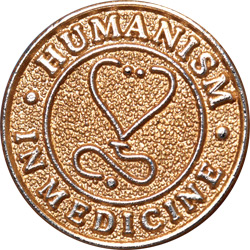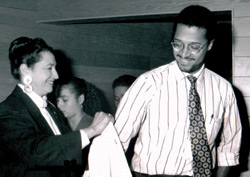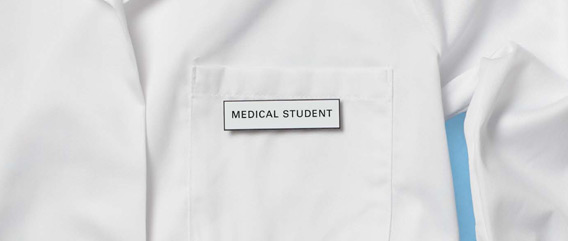Celebrating 20 Years of the White Coat Ceremony
As a medical student arriving at P&S in August of 1993, Rebecca Tennant’98 took part in the first-ever White Coat Ceremony along with 149 other students in the incoming class. Today she remembers how honored she felt to don her first white coat and recite the Hippocratic oath in front of an audience of faculty, colleagues, family, and friends.
“I always knew I was going to go into primary care and the emphasis on compassion in the ceremony really resonated with me. I was proud to be at a school that took that seriously,” says Dr. Tennant, who is now a family practice physician at the Sutter East Bay Medical Foundation in Albany, Calif.
The White Coat Ceremony is designed to welcome entering students and encourage them to start thinking about professionalism, empathy, and humanistic patient care from the very beginning of their medical training. It became an annual tradition at P&S that quickly spread to other schools of medicine, dentistry, and osteopathy throughout the United States and around the world.
In 2013, P&S celebrated the 20-year anniversary of this popular rite of passage. As in past years, the ceremony was held in the P&S Alumni Auditorium during orientation week. Remarks were delivered by P&S Dean Lee Goldman, MD; Robert E. Kelly, MD, president of NewYork-Presbyterian Hospital; and Arnold P. Gold, MD, chair emeritus of the Arnold P. Gold Foundation. Siddhartha Mukherjee, MD, PhD, assistant professor of medicine at P&S and author of the Pulitzer Prize-winning book, “The Emperor of All Maladies: A Biography of Cancer,” delivered the keynote address.
Per tradition, members of the Class of 2017 were called to the stage and “cloaked” by faculty members in a white coat that they will wear during their clinical rotations. Together, as a class, they recited the Hippocratic oath, pledging to practice their art “in uprightness and honor.”
“It’s an incredibly inspiring ceremony that conveys the spirit and the sacredness of being a physician. Students and families are sometimes brought to tears by it,” says Lisa A. Mellman, MD, P&S senior associate dean for student affairs and professor of psychiatry, who leads the recitation of the oath.
Though steeped in tradition, the ceremony has changed in small ways in recent years. In 2011, the ceremony was moved to the beginning of orientation week rather than the end to enable more family members and significant others to attend after helping the students move in. Also, the students now attend a workshop on the morning before the ceremony in which they discuss the meaning of the Hippocratic oath in small groups with faculty members and senior students. “By moving the workshop and the ceremony to the very beginning of orientation, we’re giving the students the opportunity to reflect on the privileges and responsibilities of becoming a medical student and a physician throughout the week,” says Dr. Mellman.
As they progress through medical school, P&S students will recite the Hippocratic oath again at the Student Clinician’s Ceremony that marks the transition to full-time clinical work and again at graduation.

The ceremony was originally established and continues to be sponsored by the Arnold P. Gold Foundation. A professor of clinical neurology and clinical pediatrics at P&S for more than 40 years, Dr. Gold co-founded the foundation with his wife, Sandra O. Gold, EdD, and a group of Columbia colleagues and community leaders in 1988. The foundation’s mission is to help preserve the tradition of the caring, humanistic physician through such programs as oath-taking ceremonies, symposia, professorships, and fellowships. Medical schools can apply for a grant from the foundation that covers many of the costs of launching a White Coat Ceremony.
“I believe the ceremony caught on so fast at medical schools around the world—including in places like Japan and Israel—because there was a need for it and it makes a big difference in the professionalization of the students,” says Linda Lewis, MD, former senior associate dean for student affairs and now clinical professor emeritus of neurology. Dr. Lewis served on the board of trustees of the Arnold P. Gold Foundation and for 12 years introduced the speakers and led the oath recitation at the White Coat Ceremony.
The Gold Foundation has always provided a lapel pin with its logo—a stethoscope in the shape of a heart, surrounded by the words “humanism in medicine”—for each student’s white coat. Like many other P&S alumni, Christine Taylor’97, an obstetrician/gynecologist in Durant, Okla., kept her pin as a memento and notices when a colleague is wearing one. “I remember seeing the Gold Foundation pin on a student who went to another medical school during my residency at Saint Louis University Medical Center and feeling proud that we were the first to get it,” says Dr. Taylor.
 Sandra Gold cloaking Patrice Alves’97 in 1993
Sandra Gold cloaking Patrice Alves’97 in 1993“We were all very excited and proud to be the first ones to take part in the White Coat Ceremony,” says Patrice Alves’97, an internist at San Antonio Preventive and Diagnostic Medicine in San Antonio, Texas. “When you receive that coat—even though you’re at a point when you haven’t yet undertaken the study let alone the practice of medicine—it reminds you that what you’re doing is not an easy task or something to be taken lightly. People will come to you when they are very vulnerable and you need to go ahead and help them in the way they expect. It’s very humbling.”
Hannah I. Lipman’98, associate professor of clinical medicine and chief of the Bioethics Consultation Service at Montefiore Medical Center-Albert Einstein College of Medicine, says she found it meaningful that her family was in the audience when she took part in the first White Coat Ceremony.
“It was a way to bring our loved ones with us at the beginning of the journey. I can’t imagine starting such an important journey without marking it somehow,” says Dr. Lipman.
During Albert Einstein College of Medicine’s orientation week, Dr. Lipman now helps facilitate discussions about professionalism with students as they work together to craft an oath to recite at the school’s equivalent ceremony, which is called “On Becoming a Physician Ceremony.”
“Going through the process of reading the Hippocratic oath is a way for you to start thinking about the patients you will be attending to. It helps you to stop and think that although there will be studies in the classroom, in the end you will be taking care of individuals,” says Dr. Alves.
“A White Coat Ceremony can really set the stage for demonstrating to incoming students that the faculty and the medical community are here to support them in taking on their new responsibilities, which are quite profound,” says Dr. Lipman. “It also shows that in medical education we care not only about foundational science knowledge and how to apply it in our clinical reasoning, but about things like communication skills and advocating for patients.”
For Dr. Tennant, the coat she received at the ceremony and has kept all these years serves as a reminder that taking care of people is a privilege. “I treat every patient the same regardless of how much money they have or whether or not they have insurance. That’s something I learned from the very beginning at Columbia,” she says. “I still hold in my heart the feeling that wearing that coat was the beginning of my journey to becoming the compassionate doctor that I am now.”
- Log in to post comments


